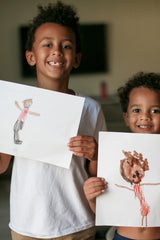Just as with everything else child-based, art follows a progression of skill development. And just like everything related to child's development, variables such as exposure, guidance, and opportunity help advance the development of art skills. However, even with all of those variables working together, a 4 year old will still not be able to independently understand and create perspective in a landscape. Viktor Lowenfeld, a scholar and advocate for Arts Education, believed there are six stages of artistic development in children. The chart below shows a general progression of drawing development by age.

The first of these stages is called The Scribble Stage, and occurs in children ages from 1-3. In this phase children make marks with no intention or representation. This stage is followed by the Preschematic Stage, which is where children age 2-4, begin to use shapes to make connections to the real world. They understand people have heads, bodies, arms, and legs, but they often are out of order, or sticking out from the wrong part. The Schematic Stage, or the third stage, occurs around 5-6 years old. In this stage, young artists have clearly defined shapes to represent objects, and their pictures will have a clear separations between sky and ground. In the fourth stage, Dawning Realism, which occurs between 7 and 9 years of age, artists start to develop a better sense of spatial relationships, but also become more critical of their work. In the Pseudo-Naturalistic Stage, also called Pseudorealism, children between the ages of 11 and 13 begin to use light and value to create more realistic works. This also brings its own level of frustration as artists are more critical of their successes. The final stage, known as the Decision Stage, occurs between the ages of 13 and 16. This stage is different than the others as it is more about the artists interest rather than their development. During this stage, artists will decide if creating art is a beneficial activity that they enjoy and want to continue, or not.

These stages are important to keep in mind as you seek out crafts and activities to do at home with your children. These are my boys self-portraits. My oldest is 6.5 and younger brother is 3.5. They talked about body parts as they drew, and of course there was some mimicking for shirt colors, but they are each unique in their own way, and I LOVE each work of art the same! So, while we all love colorful, realistic artwork to hang up at home, those scribbles and early spider-looking people are also equally as important and beautiful to display and foster their development.
There are also ways that you can support your young artists through these early stages. Some ways in which you can grow art skills for young children are:
Tracing
Tracing is when you use a dashed line to create the drawing and allow students to draw over top. This is what we typically see for early writing development, but it also works well for young artists learning to draw lines and shapes.
Hand-Over-Hand Guided Drawing
Unfortunately, this process is sometimes frowned upon, but I find it really beneficial for both early writing and drawing. For this technique, you have your artist pick up their drawing tool (pencil, crayon, marker, etc.), and then you wrap your hand over theirs to begin drawing. As you continue practicing the lines or shapes, you gradually lessen the grip your hand is using to guide theirs, so that eventually they are drawing independently.
I Do/You Do
This is a standard practice in my classroom with students of any age. For this strategy, you, as the facilitator will draw something (I Do), and the child will independently draw the same thing on their own paper (You Do). It is important to monitor the number of steps you demonstrate at a time, as some younger artists can only manage one or two steps independently before they move on.
Draw and Tell
For this strategy, you will chat about the shapes that make up what you are drawing before students draw them. So, for example, a face, you would ask the child what shape is the head (hint hint, it's not a circle), and then have them draw that shape on paper. You would talk about hair being on the top of your head, eyes being above your nose, and your nose being above your mouth. You would do this for each step of the drawing, so students are working to develop their observational drawing skills as well.
Creating Adult Samples
This is again another debatable practice in the art world because it often causes frustration and imposter syndrome for young artists. However, the positive of having a finished sample is that students have a visual of the end product. Sometimes when young artists are creating more abstract drawings, it is difficult for them to envision what the end should look like. Having a sample for reference can provide benefits for them to be more successful throughout the entire drawing process. But, it is very important to discuss the differences of art created by adults and art created by children in terms of skill, and also that copying others artwork is a big no no, so while they can reference your work, the goal is not to replicate it.
So I share all of this with you because I still believe the NUMBER ONE way to grow the skills of your aspiring artist is to give them ample opportunities and supplies to create. Hopefully some of these tips and research will help you better foster a love for the arts in your children!
Happy Creating Mamas! -Ally

